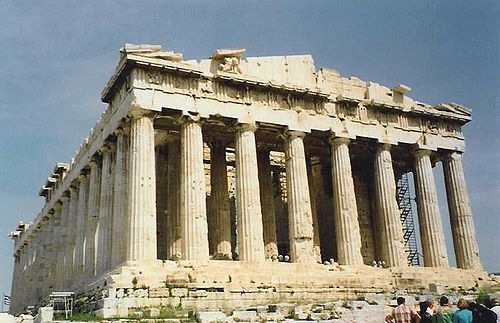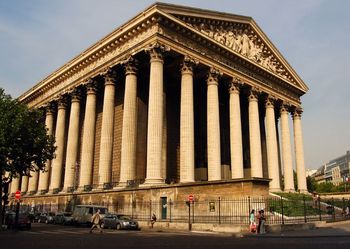Greek Architecture
 From Conservapedia
From Conservapedia Greek architecture arose on the shores of the Aegean Sea and flourished in the ancient world. Most of our knowledge of Greek architecture comes from the few surviving buildings of the Classical, Hellenistic and Roman periods (since Roman architecture heavily copied Greek), and from late written sources such as Vitruvius (1st century AD). [1]
The most important works of Greek architecture were produced between 700 BC and 146 BC. Architects Callicrates, Mnesicles, and Ictinus flourished, and the Parthenon (Its most famous monument) and other great works were produced. The Parthenon was built using the golden proportion (0.618 : 1) by Ictinus, Callicrates and Phidias, ca. 440 BC.; there is a replica of it at Nashville, Tennessee. Another piece of Greek architecture was the magnificent Temple of Artemis at Ephesus, one of the Seven Wonders of the Ancient World; Paeonius and Demetrios were the architects of this temple in ca. 250 BC. The Temple of Nike by Callicrates, ca. 420 BC., was the earliest Ionic building on the Acropolis.
There were three main styles or orders of Greek architecture: the Doric, the Ionic and the more ornate Corinthian. The styles are also known for their column capitals.
Greek architecture has a strong influence on Western Culture even today.
L'église de la Madeleine in Paris was designed in its present form as a temple to the glory of Napoleon's army.
Washington, D. C. and Philadelphia have notable examples of ancient Greek architecture.
See also[edit]
External links[edit]
- Architecture in ancient Greece
- Greek Architecture
- Ancient Greek Architecture Buildings and Architects.
Categories: [Ancient Greece]
↧ Download as ZWI file | Last modified: 03/26/2023 17:45:06 | 20 views
☰ Source: https://www.conservapedia.com/Greek_architecture | License: CC BY-SA 3.0
 ZWI signed:
ZWI signed:



 KSF
KSF